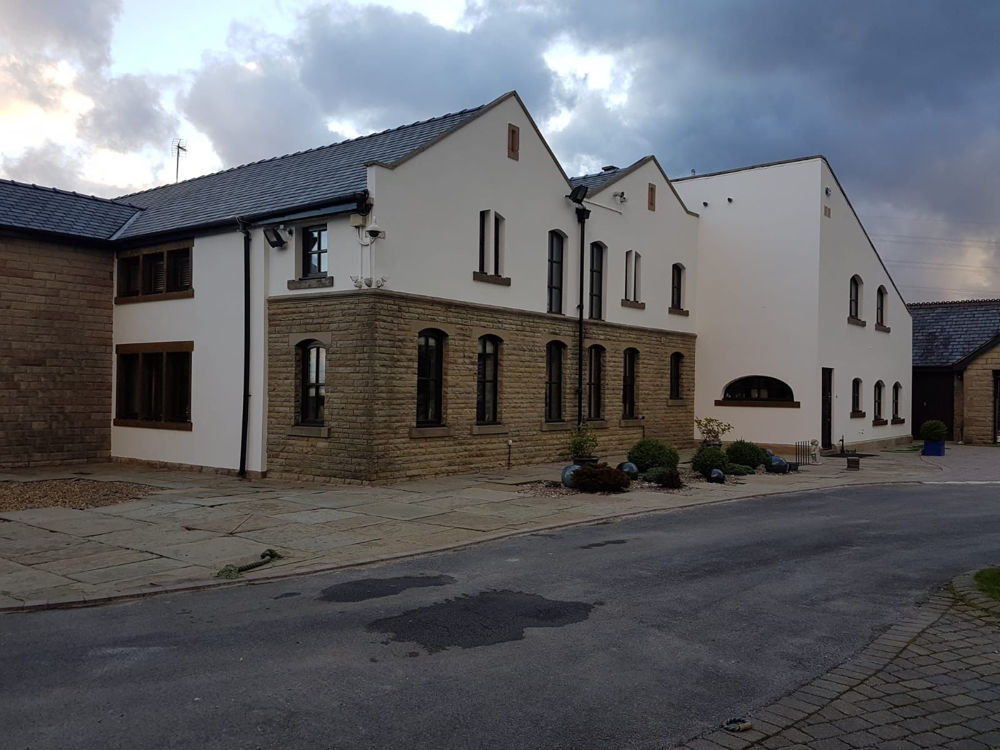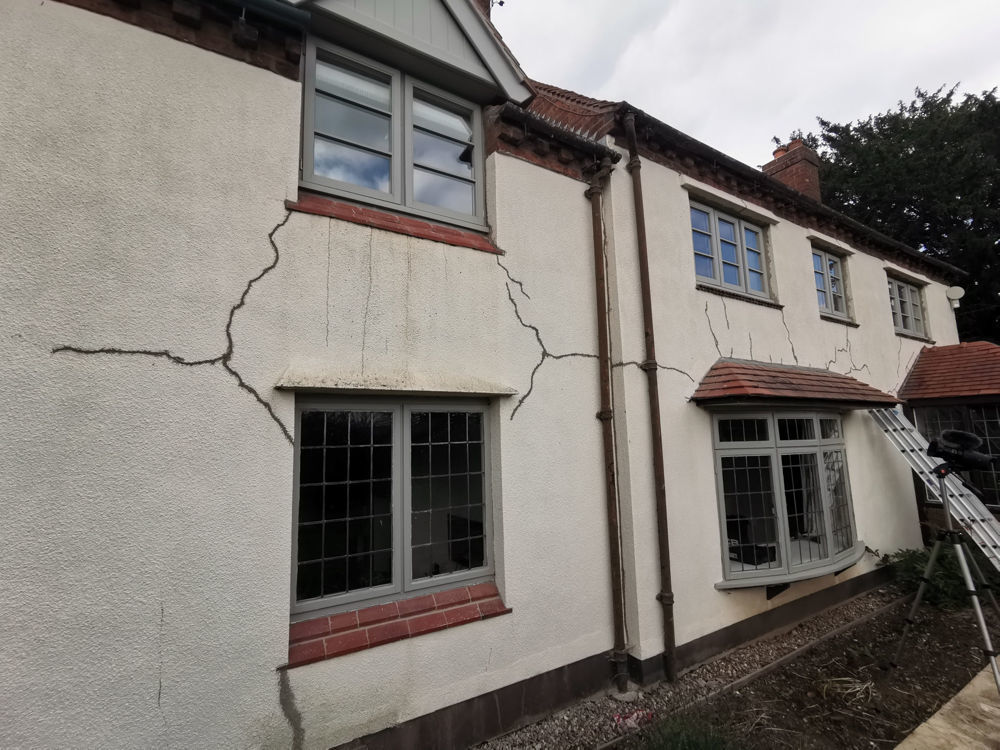
As with any decorating project, ensuring you take the appropriate course of action when it comes to painting exterior renders such as K-Rend is crucial. Our team of experts have put together this ultimate guide to painting silicone render to give you as much information as possible, so you can achieve beautiful, long-lasting results.
What Is K-Rend?
The very first part of any decorating project is understanding the substrate you are painting, so what exactly is K-Rend? K-Rend is a brand of silicone render that is designed for application to exterior walls. The K-Rend brand produces a range of external renders that offer a high-quality coloured finish that provides durability and weatherproof protection to the exterior of properties. They are hugely popular as they can make any property look brand new, helping to cover damaged or tired looking brickwork. K-Rend represents the most popular brand of silicone render currently in the UK, although other brands of silicone render include Weber and Remmers.
Silicone Renders
Silicone renders generally last upwards of 25 years thanks to their ability to flex with the movement of external walls and their high breathability. You may be wondering, what do we mean by breathability?
One of the most common causes of exterior coating failure is moisture. When moisture gets into external walls through cracks, it can become trapped by coatings & renders with low breathability. This is in contrast to renders and coatings that are highly breathable, that allow water vapour within the brick to evaporate out of the wall. If this moisture cannot escape, it will build underneath the surface, eventually causing any render to 'blow', causing large cracks and crumbling render that will expose the bare brickwork beneath. These gaps within the integrity of the render will allow further water ingress, causing deterioration that will get progressively worse with time.

Painting Silicone Renders
High-tech silicone renders due to their technology shouldn't be painted using any masonry paint. Most standard masonry paints are acrylic-based, which generally means they have quite low breathability. This means that they can seal the silicone render, negating the breathability of the render itself. Acrylic masonry paints are also often found to have poorer adhesion to silicone-based renders. Silicone masonry paints are higher-quality formulations that provide long-term performance thanks to their high breathability, which is why they are recommended for use with silicone renders.
You may be wondering why would you paint a silicone render if they offer a coloured external finish? There are a number of reasons why homeowner may decide to paint their render.
1. DISCOLOURATION
Some silicone renders can be prone to discolouration and algae growth, which can significantly impact the kerb appeal of the property. The discolouration of the render itself has often been attributed to sunlight and UV rays, which can cause the colour of the render to fade over time. Algae and other green growth are microorganisms that can attach themselves to the render in moist conditions, causing large amounts of staining to the render, making it look dirty. Instead of continuously cleaning render on an annual basis, which some render manufacturers recommend, an alternative is to paint them.
2. A CHANGE OF COLOUR
Sometimes we all fancy a change, which is why painting render can be very popular, especially in a newly bought house that you are looking to stamp your personality on. Masonry paint comes in a range of colours that can completely transform the look of your house, no matter whether it is a traditional period property or a new build.
3. TO COVER CRACKS
If cracks or other signs of damage has appeared on your render, repairing these and then applying a masonry paint is an effective way of restoring the render to its former glory. It is important to note that fixing any defects is crucial first before you apply paint as these will simply re-appear in no time if not properly dealt with.
What Paint To Use On Silicone Render
Now we have established that silicone renders can be painted and some of the key considerations, it is time to discuss what paint to use when painting silicone render. As we have previously mentioned, while acrylic masonry paint can be applied to silicone render, the lack of breathability does not make it the best option. To maintain the benefits of silicone render, a silicone masonry paint should be used that maintains full breathability while also offering weather protection.
This is why Emperor Masonry Paint was developed, which is a completely waterproof masonry paint that repels any water away from the external wall. It does this using the latest nano-technology which creates a super hydrophobic surface on exterior walls that reduces water absorption by 96%. This means that even the heaviest of rain will not be able to get underneath the paint film, which is the most common cause of failure in masonry paint.

While providing this level of weather protection, Emperor Masonry Paint has been shown to maintain high breathability, with an SD rating of 0.03. For a masonry paint to be considered breathable, it must have an SD value of under 1.
This combination of water repellence and breathability is what provides Emperor Masonry Paint with a proven 25+ year performance in harsh weather conditions, as shown in independent tests conducted by UKAS accredited laboratory Lucideon. By helping to reduce water ingress and maintaining breathability, a one-way path for moisture is created that keeps external walls dry, preventing the damage that is caused by moisture attacking render. After the 25-year accelerated independent testing was conducted in the laboratory, there was no sign of deterioration in appearance or performance of the exterior wall treated with Emperor Masonry Paint, demonstrating that the masonry paint will likely far exceed a 25-year life expectancy.
Due to this, a lifetime guarantee is offered on the paint.
The water repellent properties of Emperor Masonry Paint also help to prevent the discolouration that can sometimes occur with renders. By creating a water repellent surface on render, any dirt, algae & other growth struggle to attach itself to the painted render, simply falling off with any rainfall. The masonry paint is also resistant to UV rays, preventing any UV degradation that will cause the render to discolour and fade over time.
How To Paint Silicone Renders
If you are looking to paint silicone renders, it is important that you take the correct steps to ensure long-term performance. While it can often be tempting to leave out a step when decorating, each stage of the process is crucial if you want the best possible results.
YOU WILL NEED:
- Emperor Masonry Paint
- Long-pile paint roller
- Paint tray or scuttle
- Paint brush
- 120 grit sandpaper
- Dust sheets
- Window film
- Masking tape
- Exterior filler & filling knife (may be required)
- Scraper (may be required)
1. PREPARATION
Preparation is one of the most important parts of the decorating process. If you do not ensure the render is ready to paint, you will inevitably experience problems with paint peeling or flaking off the render.
The very first part of the process for preparing render to be painted is to ensure it is sound. Any holes or cracks should be filled as this will limit moisture from getting underneath the paint film. Start by removing any loose mortar and rubble from the hole or crack using a filling knife. Using a good exterior filler such as the Toupret Masonry Repair Filler, fill any cracks or holes by working the filler using a filling knife back and forth. Once left to completely dry, sand this back using 120-grit sandpaper to get a perfectly smooth surface ready to paint. If the render has been previously painted, remove any loose or flaking paint using a stiff brush and a paint scraper.
Once the surface completely sound and free from damage, the next step is to clean it. This is crucially important as any green growth or fungus that is left underneath the paint film can bloom, causing the paint to peel and flake. A fungicidal masonry cleaner such as Emperor Masonry Cleaner will kill any growth. Before you apply the fungicidal wash, remove any dirt and debris from the wall using a stiff brush as this will prevent the paint from properly adhering to the render. Once clean, apply the fungicidal wash to the render using a brush and leave it for two hours to attack any fungus. Once two hours has passed, the wall will be clean and free from fungus. You do not need to wash the cleaning residue off the render as this will be painted over.
Lastly, cover any surfaces that you do not want to paint. This will not only ensure a neat finish but will prevent any unwanted clean up. Emperor Masonry Paint is a tough, durable masonry paint that once dry will not be cleaned off with ease. Putting a dustsheet or large cover on the floor will prevent any paint splatter, while masking tape applied to any edges such as around doors and other parts of exterior trim will provide you with a perfectly neat finish. Applying masking film to windows is a good idea to completely protect your windows. When choosing an exterior masking tape, a good-quality exterior masking tape is best suited for the job as it will prevent any paint bleed through.
2. PRIMING
With silicone renders you do not need to apply a primer as these are coloured finishes that are not highly porous. A cement render that has not previously been painted would require a primer however.
If you are painting a bare render, ensure you use an appropriate primer. With Emperor Masonry Paint, Emperor Exterior Primer must be used, which contains the same super hydrophobic technology as the paint. Apply a thin but even coating of the primer to the surface using a paint brush or a roller and leave to dry completely for 3-5 hours.
3. PAINTING
Once the render is sound, clean and primed (if required), it is time to start painting. It is important that you ensure you are not painting in particularly low or high temperatures. Temperatures below 5°C will prevent the paint from drying, while temperatures above 20°C will cause the paint to dry too quickly, which will result in the paint drying at different rates, leaving an uneven finish. It is also important that you do not paint render while it is wet or when there is a chance of rain. Moisture rich conditions will impact the ability for the masonry paint to adhere to the surface, potentially causing failure. Pick a dry weekend where you will have a chance to apply two full coats of paint without the risk of showers.

Starting from the top of the render, use a paint brush to cut around the edges of the render. Once this is done, use your long-pile masonry roller to apply the first coat of paint, aiming for a coverage of between 5-8m2 per litre, depending on the roughness of the render. This must be allowed to dry for 8 hours before you apply a recoat the paint. You can dilute the first coat of paint by 10% to allow a better coverage of the paint. Apply the second coat to the render undiluted, ensuring the most even finish possible as this will be your final coat. Allow this to dry before removing masking tape & window film. You can then clean your equipment using warm soapy water as Emperor Masonry Paint is a water-based paint.

Frequently Asked Questions
Q. CAN YOU PAINT DAMP RENDER?
Surfaces must be completely dry before painting, especially with a water-based paint like the vast majority of masonry paints are. If your render has been suffering from large damp patches, simply allow these to dry before applying Emperor Masonry Paint. Over time, by waterproofing render this damp will subside as the escaping water vapour and the water repellencey gradually reduces the moisture levels.
Q. WHAT COLOURS ARE AVAILABLE?
Emperor Masonry Paint comes in 18 popular colours as standard, including white, beige, mushroom, witney cream, and light grey. Why not visit of colour inspiration gallery to see all of the colours available.
Q. WHAT IS THE BEST ROLLER FOR MASONRY PAINT?
We recommend using a long-pile paint roller, which is best suited for exterior surfaces such as render. This thick roller sleeve allows more paint to be picked up, providing excellent coverage, plus the long fibres are able to apply paint to all parts of the render effectively.
Q. DOES RENDER HAVE TO BE PAINTED?
Often silicone render comes pre-coloured and does not have to be painted. Painting them using a technology like Emperor Masonry Paint simply allows them to be freshly painted if they have been damaged, plus it can help to prevent algae attaching to the surface of the render, keeping them looking pristine for decades to come. In contrast with this, it is recommended by some silicone render manufacturers to treat the render every 12 months with fungicide.
Q. HOW DO YOU CLEAN A K-REND WALL?
Cleaning K-rend and other renders is generally advised after a few years as they can begin to discolour and develop staining. The render can be cleaned using a pressure washer in order to dislodge any surface-level dirt and grime. The problem is, some discolouration and staining can't always be removed from the render. This is why painting render is often the best solution in order to cover staining and prevent it re-occurring in the future.
Want more information regarding painting silicone render? Our in-house experts are on hand to answer any questions you may have about the full painting process. Contact one of our experts or shop Emperor Masonry Paint with FREE delivery on all orders.

